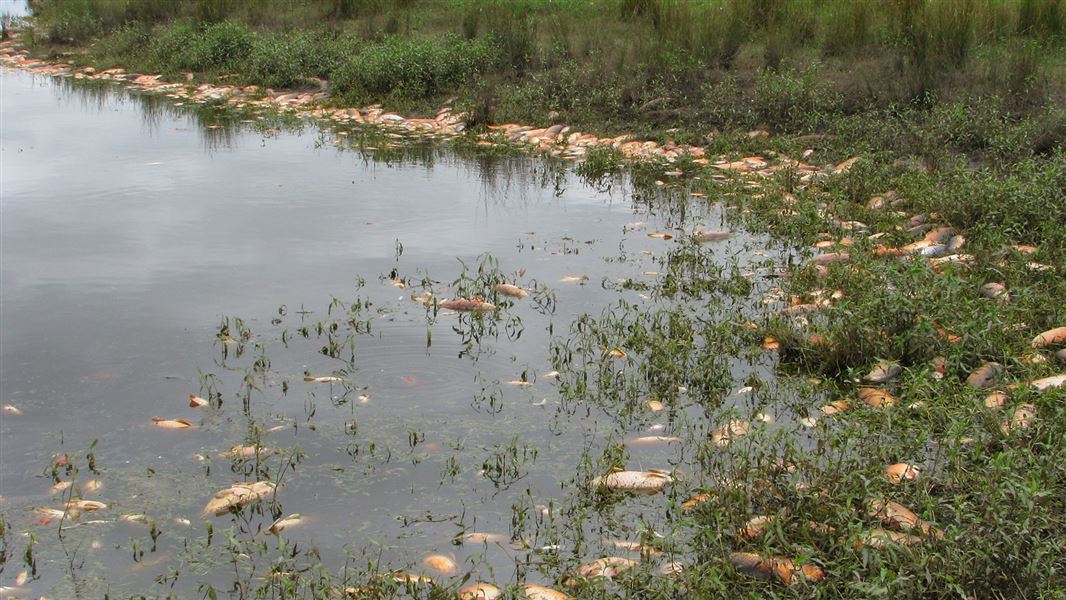Koi carp look very like goldfish, except they grow to larger sizes (in New Zealand up to 10 kg and 75 cm long) and have two pairs of whisker-like feelers, also called barbels, at the corners of their mouth.
They are highly variable in colour, often accompanied with irregular blotching of black, red, gold, orange or pearly white.
Koi carp prefer still waters in lakes, or backwaters in rivers. They are highly tolerant of poor water quality and contribute to water quality decline.
Report sightings of koi carp outside the Auckland-Waikato region to 0800 DOC HOT (0800 362 468).
Image gallery
Koi carp are an ornamental strain of the common carp (Cyprinus rubrofuscus) native to Asia and Europe. This species is thought to have been imported into New Zealand accidentally in the 1960s as part of a goldfish consignment.
Wild stocks of koi carp were first found in the Waikato River in 1983, by which time they had likely established a breeding population and begun to spread naturally, during floods and accidentally or intentionally by people.
Further illegal introductions have occurred elsewhere, for coarse fishing (a traditional British pastime involving the catch and release of certain species including koi carp, rudd, perch and tench) and for ornamental purposes. Isolated populations have been progressively discovered throughout the North Island .
What damage do they do?
When koi carp feed they stir up the bottom of ponds, lakes and rivers, muddying the water and destroying native plant and fish habitat. Koi carp are opportunistic omnivores, eating a wide range of food, including insects, fish eggs, juvenile fish of other species and a diverse range of plants and other organic matter.
They feed like a vacuum cleaner, sucking up everything and blowing out what isn’t wanted. Aquatic plants are dislodged in the process and are unlikely to re-establish. Koi carp cause habitat loss for plants, native fish, invertebrates and waterfowl. They can also worsen river erosion by undermining banks as they feed.
Legal designation
- Unwanted Organism
- Noxious fish
It is an offence to sell, breed or distribute any Unwanted Organism under Sections 52 and 53 of the Biosecurity Act 1993. Moving live koi carp is also an offence. Penalties include a fine of up to $100,000 and/or imprisonment up to 5 years (Section 157 (1)).
People who possess, control, rear, raise, hatch or consign Noxious Fish without authority are liable for a fine of $5,000 under the Freshwater Fisheries Regulations 1983.
Under Section 26ZM of the Conservation Act 1987, any person who transfers or releases live aquatic life into any freshwater without prior approval commits an offence and is liable for a fine of up to $5,000.
What’s being done to control koi carp
Containment area – Auckland and Hamilton
To help stop their spread, a containment area between Auckland and Hamilton was established in 1990.
Map of the containment area (PDF, 104K)
The commercial harvest of koi carp can take place from waters within the koi carp containment area but you will need approval. See Harvesting koi carp.
Recreational fishing is permitted, but all koi must be killed when caught.
Koi are widespread in Northland, Auckland and the Waikato River catchment downstream of Lake Arapuni. They are now found in the Waihou and Piako Rivers. They are also located in isolated places throughout the North Island except East Cape/Gisborne.
There are no known populations of koi carp in the South Island.
Koi carp have been eradicated from small sites throughout the North Island. Illegal releases of koi carp in the Nelson/Marlborough area in 2000 were eradicated.
Control options
Controlling koi is limited by the small range of tools available and the ability of those those tools to make real impacts on the koi carp population. Although the eradication of koi is highly desirable, it is a challenging goal.
Existing tools to control koi include manual removal using nets, traps, electric fishing or recreational fishing, and draining the water body, the use of toxins and selective barriers. These are generally not effective on their own and need to be used in combinations suiting each situation.
Most of the tools are only effective in enclosed/isolated and/or non-flowing water bodies and would not work in an open catchment system, such as a river. None of the existing control tools can specifically target koi, so their use needs to be considered carefully with regard to potential impacts on New Zealand’s native species
Current work programmes are focussed on exploring new and innovative control tools. This includes drone and eDNA surveillance and commencing a project for a species-specific virus.
Koi carp control tools - what's currently available and new tools being explored.
